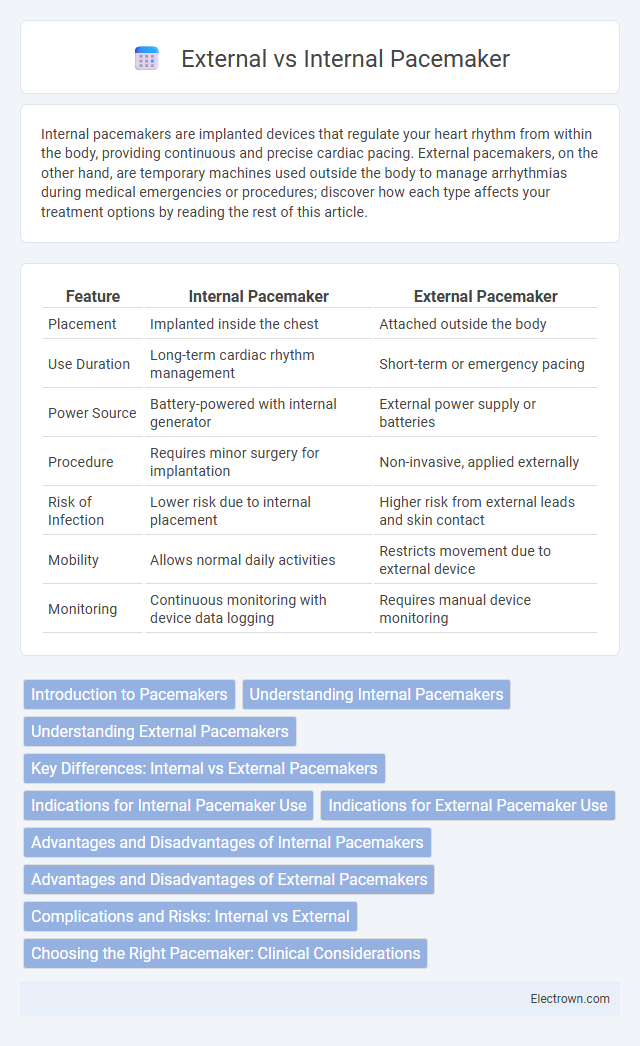Internal pacemakers are implanted devices that regulate your heart rhythm from within the body, providing continuous and precise cardiac pacing. External pacemakers, on the other hand, are temporary machines used outside the body to manage arrhythmias during medical emergencies or procedures; discover how each type affects your treatment options by reading the rest of this article.
Table of Comparison
| Feature | Internal Pacemaker | External Pacemaker |
|---|---|---|
| Placement | Implanted inside the chest | Attached outside the body |
| Use Duration | Long-term cardiac rhythm management | Short-term or emergency pacing |
| Power Source | Battery-powered with internal generator | External power supply or batteries |
| Procedure | Requires minor surgery for implantation | Non-invasive, applied externally |
| Risk of Infection | Lower risk due to internal placement | Higher risk from external leads and skin contact |
| Mobility | Allows normal daily activities | Restricts movement due to external device |
| Monitoring | Continuous monitoring with device data logging | Requires manual device monitoring |
Introduction to Pacemakers
A pacemaker is a medical device that regulates abnormal heart rhythms by delivering electrical impulses to the heart muscles. Internal pacemakers, also known as implantable pacemakers, are surgically placed inside the body to provide continuous heart rhythm support, while external pacemakers are temporary devices used externally in emergency or surgical settings. Understanding the differences between internal and external pacemakers helps you make informed decisions about cardiac care and treatment options.
Understanding Internal Pacemakers
Internal pacemakers are medical devices implanted within the body to regulate abnormal heart rhythms by sending electrical impulses directly to the heart muscle. These devices consist of a pulse generator and leads, which monitor heart activity and deliver stimuli as needed, ensuring consistent heartbeats. Understanding how your internal pacemaker functions can help optimize your heart health and guide you in managing related symptoms effectively.
Understanding External Pacemakers
External pacemakers provide temporary cardiac rhythm support through electrodes attached to the skin or directly to the heart during emergencies or surgeries. These devices deliver electrical impulses to stimulate the heart when intrinsic pacing is inadequate, ensuring adequate heart rate and cardiac output. External pacemakers are crucial for rapid intervention but require careful monitoring to prevent complications such as infection or lead displacement.
Key Differences: Internal vs External Pacemakers
Internal pacemakers are surgically implanted devices that regulate heart rhythm from inside the body, offering long-term management with lower risk of infection and greater patient mobility. External pacemakers are temporary, external devices connected via electrodes to the heart, often used in emergency or post-operative settings for short-term cardiac support. The key differences lie in their application duration, invasiveness, risk profile, and patient lifestyle impact.
Indications for Internal Pacemaker Use
Internal pacemakers are primarily indicated for patients with symptomatic bradycardia resulting from conditions like sick sinus syndrome, atrioventricular block, or heart failure requiring cardiac resynchronization therapy. Your healthcare provider may recommend an internal pacemaker when external pacing is insufficient, or long-term rhythm management is necessary to prevent complications such as syncope or heart failure progression. These devices offer reliable, continuous cardiac support tailored to individual rhythm abnormalities.
Indications for External Pacemaker Use
External pacemakers are primarily indicated for temporary cardiac pacing in cases of acute bradycardia, heart block, or during emergency resuscitation when immediate heart rate control is essential. They are also used as a bridge to permanent pacemaker implantation in patients with transient conduction system disturbances or during cardiac surgery. External pacing is critical in managing patients with symptomatic bradyarrhythmias unresponsive to pharmacologic therapy or in post-operative cardiac care to ensure hemodynamic stability.
Advantages and Disadvantages of Internal Pacemakers
Internal pacemakers offer the advantage of reduced risk of infection and greater convenience since the device is implanted under the skin, minimizing external exposure. These devices provide continuous, reliable cardiac pacing without restricting physical activity, improving patient quality of life. However, internal pacemakers require surgical implantation and periodic battery replacement through additional procedures, which pose potential risks and higher costs.
Advantages and Disadvantages of External Pacemakers
External pacemakers offer temporary cardiac pacing with ease of application and immediate adjustability, making them ideal for acute scenarios such as post-operative cardiac care or emergency resuscitation. However, their disadvantages include higher risks of infection, discomfort due to external wires, limited mobility for patients, and less reliability for long-term pacing compared to implanted internal pacemakers. External devices also require continuous monitoring and are prone to dislodgement or malfunction in unstable patients.
Complications and Risks: Internal vs External
Internal pacemakers carry risks such as infection at the implantation site, lead displacement, and battery failure, which may require surgical intervention. External pacemakers pose complications including skin irritation, infection at electrode sites, and limited mobility, making them less suitable for long-term use. Your healthcare provider will assess these factors to determine the safest and most effective option based on your medical condition.
Choosing the Right Pacemaker: Clinical Considerations
Choosing the right pacemaker depends on clinical considerations such as the patient's specific cardiac condition, infection risk, and lifestyle factors. Internal pacemakers are typically preferred for long-term management of bradyarrhythmias due to their reliability and reduced infection risk, while external pacemakers serve as temporary solutions during acute settings like perioperative periods or emergencies. Evaluating factors like battery longevity, lead placement, and patient's mobility ensures optimal device selection and improved cardiac function.
Internal vs External Pacemaker Infographic

 electrown.com
electrown.com